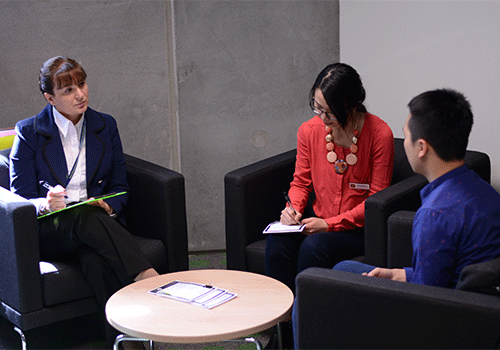How Can We Help?
What is interpreting?
Interpreting is the oral translation of speech between two different spoken languages.
Who is an interpreter?
An interpreter is a professional who is qualified to convert speech accurately and objectively into another language and required to act in accordance with a code of ethics. An interpreter must remain impartial, not express an opinion and not act as an advocate for a client. For these reasons, family members, friends and bilingual staff are not interpreters. In Australia, the National Accreditation Authority for Translators and Interpreters (NAATI) is responsible for maintaining the quality of interpreters. Victorian Government policy is to engage NAATI accredited Professional interpreters (or higher). Where this is not possible, a lower credentialed interpreter can be engaged.
Tips:
- Find out more about the NAATI credentialing.
- Find out more about the interpreters’ code of ethics.
- Find out more about the communication roles of bilingual staff by consulting CEH information sheets on this topic.
Where do I find an interpreter?
The three most commonly used sources for interpreters are the Yellow Pages, NAATI and Australian Institute of Interpreters and Translators (AUSIT) websites. Agencies that arrange the supply of accredited interpreters can be found at the Victorian Multicultural Commission Community Directory by selecting ‘Interpreting and translating organisations’ from the ‘Organisation type’ dropdown menu. Tip: In most cases, government departments and funded agencies will have a contract with an interpreting agency and do not need to seek out individual interpreters.
What ways can an interpreter be engaged?
There are three ways of communicating with a client via an interpreter: face-to-face (onsite), telephone and videoconference. Face-to-face interpreting requires you, the interpreter and the client to be physically present in the one location. With telephone and videoconferencing, either the interpreter or client may be present with you or each person can be in a separate location. Face-to-face interpreting should be engaged when complex, legally binding or lengthy matters need to be discussed. Face- to-face interpreting has the advantage of taking into account body language. Telephone interpreting is useful for shorter, less complex communication or when an extra level of confidentiality is necessary. Telephone interpreting is useful in emergency situations when immediate assistance is required. Telephone interpreting can be used as a first step before engaging a face-to-face interpreter to identify the language needed or to determine the nature of an enquiry. Telephone interpreting may be the only option in some cases when a face-to-face interpreter cannot be accessed and when videoconferencing is not available. Videoconferencing, where available, offers the advantage of visual contact over telephone interpreting. The Department of Human Services provides a Video Relay Interpreting (VRI) service for deaf and hard of hearing people.
What interpreting styles are there?
Interpreting is performed in different styles, determined by the setting and topic. Knowing the difference between interpreting styles will help to determine which style is best for the situation. The three main styles are outlined below.
Consecutive interpreting: is where the speaker and the interpreter speak one after the other. The interpreter listens to a few sentences or messages and then relays this in the other language while the speaker listens. The speaker will continue and the process repeats itself. This is the most common style of interpreting in the government, health and community sectors. Consecutive interpreting is used in interviews, question and answer sessions, presentations, court hearings and conference calls.
Chuchotage interpreting: is simultaneous interpreting in a whisper (thus also known as ‘whispered/ whispering interpreting’) without the use of an isolation booth for the benefit of a person or small number of people listening to speech in a language in which they are not fluent. The interpreter is positioned near to the target listener(s) and then whispers the speaker’s message so as not to disturb the speaker or other listeners fluent in that language. Chuchotage can be performed so it does not to interfere with the flow of thought or speech of the speaker(s), but only if they are comfortable with this mode of interpreting. Whispered interpreting is used in court proceedings, information sessions in large multilingual settings and consultations with clients and their families, such as undertaking a mental health assessment.
Simultaneous interpreting: involves the interpreter listening to the first words the speaker says and then proceeding to interpret the words continuously (with a slight delay) as the speaker continues to talk, so that the speaker and the interpreter are speaking simultaneously. Simultaneous interpreting, also known as ‘conference interpreting’ when performed in a soundproof conference booth, requires a higher level of skill than consecutive interpreting.
Tip: If you are unsure what style of interpreting is needed, consult your interpreter agency.
What seating formations are there?
For face-to-face interpreting, communication can be improved by choosing the best seating formations.
- A triangle formation is best for three people: you, the interpreter and your client.
- A horseshoe formation or circular formation is better when an additional one or two people are involved, such as a carer, family member or another worker.
- A circular formation is used for a group of six or more people, such as in a focus group or a family conference.
In horseshoe and circular formations the interpreter is often seated next to the worker and the client; however, this depends on the purpose of the discussion and the style of interpreting needed.
Tip: If you are unsure what seating formation is best, consult your interpreter during your briefing.

What about machine interpreting?
Machine interpreting (also known as automated interpreting) converts spoken words into different languages. Machine interpreting does have its place in certain industries where the dialogue may be more straightforward and involve the use of specific trade and business terminology or repeated terms and phrases. Smartphones and tablets can be loaded with applications to perform machine interpreting. While the applications combine two forms of technology − voice recognition software and machine translation – there are still glitches in both, which makes this an unreliable form of communication. Within an immigrant society such as Australia, additional complications such as heavy accents, mispronunciations and regional dialects compromise the effectiveness of this technology. Consistent with government policy on the use of qualified translators, qualified interpreters should be used over machine interpreting.
Links to other tip sheets in the language services series
This information sheet is one of a series produced by the Centre for Culture Ethnicity & Health (CEH) covering aspects of language services. Other tip sheets in this series include:
- Assessing the need for an interpreter (2014): Whenever possible, the need for an interpreter should be decided before an appointment…
- Booking and briefing an interpreter (2014): Getting the best interpreter starts at the booking stage.
- Communicating via an interpreter (2014): Here are some tips to make the interpreted conversation more effective and efficient…
- Debriefing with an interpreter (2014): The debriefing a mutual learning process and contributes to a higher quality of communication…
- Translation: an introduction (2014): Translation means converting written information from one language into another…
- Planning for translation (2014): Undertaking translation is a process and should be considered a project with a budget and timelines…
- Recruiting bilingual staff (2014): Victorian Government language services policy recognises bilingual staff as a valuable part of an agency’s language services response to people with limited English proficiency…
- Managing bilingual staff (2014): Bilingualism is the ability to communicate in two languages with equal, or near equal, fluency…
- Developing a comprehensive language services response (2014): Language services encompass a range of services that facilitate communication with clients with limited English language proficiency…
Resource Type: Tip/Fact Sheets

